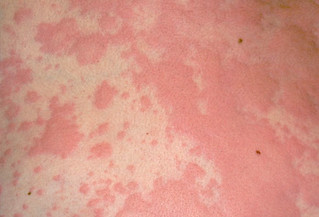Marcia kept getting a rash all over her body – red, raised, itchy. The welts or hives would fade away, and then quickly come back. The itching and redness would resolve with Benadryl, but when it wore off, the welts would come back. She changed to a mild soap that was hypoallergenic. She changed her laundry detergent. She stopped using lotion and perfume. The rash kept coming back, going away, and coming back, over and over again. She was starting to worry about having a serious condition.
 After a couple weeks, she went to the doctor.
After a couple weeks, she went to the doctor.
The dermatologist took an extensive history and examined her carefully before saying with great certainty, “You have urticaria.”
“I knew it!,” said Marcia, “I knew that I had something. I knew it.” She was so relieved to have a diagnosis. Now that she knew it was serious, she could get on with the treatment. “That’s fantastic. You are such an excellent dermatologist. I knew that you would know what I have.”
The dermatologist looked at her confused, “You do know what urticaria means don’t you?”
“Well … no,” admitted Marcia.
“It means that you have allergic hives.”
Marcia’s excitement deflated almost immediately. She already knew that.
Symptoms and Syndromes
In medical diagnosis, there are a few conditions that are defined by a constellation of symptoms that occur together (a syndrome). These are diagnoses of exclusion. You must exclude the presence of other known underlying causes of the symptoms. For Marcia, urticaria is the medical term for the classic allergic skin reaction, but it does not name the underlying cause.
Fibromyalgia
One example of a syndrome is fibromyalgia. There are specific criteria to fit this diagnosis, but briefly described, fibromyalgia is a chronic disorder characterized by muscle pain and tenderness.
Patient: “I have muscle pain and tenderness.”
Doctor: “You have fibromyalgia.”
At first glace, it may seem that the doctor is just repeating. “You have muscle pain and tenderness.” However, fibromyalgia means that you have muscle pain and tenderness that does not fit into any other known disease. Because it is a diagnosis of exclusion, if you discover an underlying cause, such as “Oh, that’s because you got hit by a baseball bat, there’s also a bruise there.” Now you have a traumatic injury, not fibromyalgia.
Chronic Fatigue Syndrome
Patient: “I am so tired all the time.”
Doctor: “You have chronic fatigue syndrome.”
The doctor has done tests to rule out other causes of the chronic fatigue. As a diagnosis of exclusion, we now have a label for this disease, but we do not know the underlying cause.
Diagnosis of Exclusion
Why is this useful? All the people that fit in the bucket of “chronic fatigue syndrome” might not have the same cause, but now we can study them as a group and see what they have in common. We can also study treatments that might help this bucket of people, even though we don’t know the underlying cause. We study the group in the hopes of finding an underlying cause or causes. Once the cause is named, we take it out of the bucket. While you may still have the symptom of “chronic fatigue,” you no longer have “chronic fatigue syndrome.” You now have chronic fatigue due to X, where X is the underlying cause.
In a medical climate where people are searching for a “diagnosis,” the “Diagnosis of Exclusion” can sometimes make these edges of medicine seem like a solved problem where we can develop drugs for symptoms. However, the work of medicine is at these edges where we explore the things that we do not understand. The name is just a handle to describe the problem, but it does not give us any power over it until we can find and treat the underlying cause.
Urticaria
Back to Marcia’s story, she was a lovely elderly Jewish lady that told me this story with so much self-deprecating humor. She didn’t take herself seriously, and she felt that we could all learn something from her story.
The most common cause of urticaria is “idiopathic” (which means “I have no idea why you have this.”) Most cases of urticaria resolve after several weeks with only symptomatic treatment and removing of common allergens. The lucky few figure out the trigger and learn to avoid it. During a reactive phase of urticaria, the skin is sometimes sensitive to everything and anything that it may not have been allergic to before. After the immune system quiets down, the skin returns to normal. However, the condition may flare again.
Key Definitions:
- Symptom = the complaint of the patient
- Syndrome = a constellation of symptoms that commonly occur together. A disease may have a classic syndrome, or a syndrome with an unknown cause can be a disorder.
- Disease = the underlying cause of the symptoms
- Disorder = the underlying cause might not be known. It may define a syndrome.
- Diagnosis of Exclusion = all known causes must be excluded before this “diagnosis” can be made.